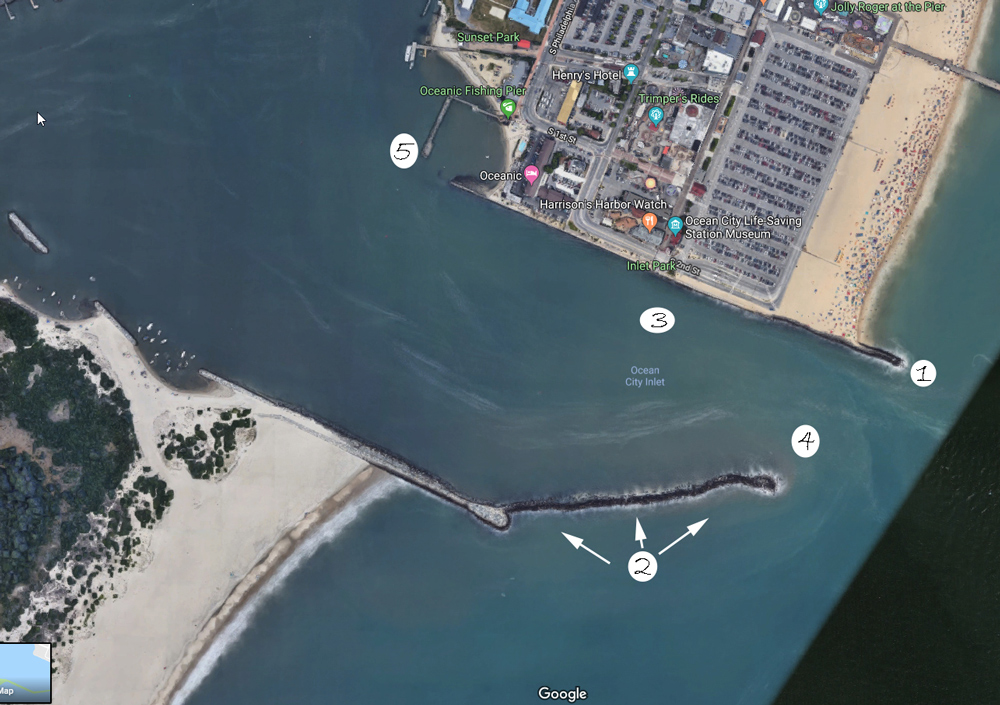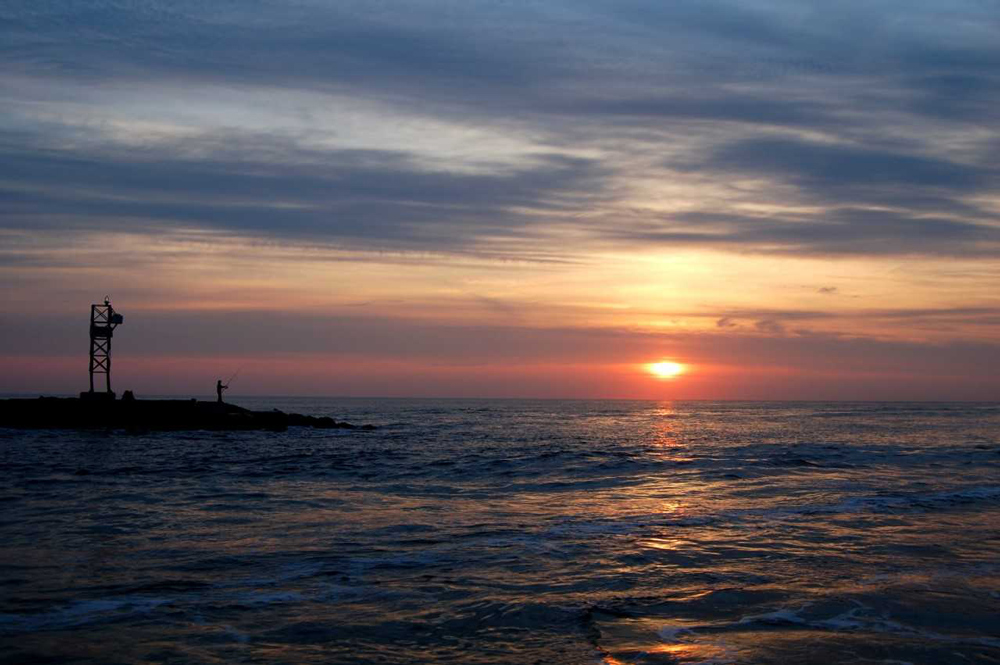There's some excellent fishing to be found in the Ocean City, MD inlet, especially at these five top hotspots:
- Tip of the North inlet jetty - striped bass, bluefish, and tautog.
- Outside wall of the South jetty - sheepshead and tautog.
- Sandy bottom inside the North jetty - flounder.
- Drop-off near the tip of the South jetty - striped bass, flounder, bluefish, and shad.
- Oceanic Fishing Pier - flounder, stripers, bluefish, croaker, spot, shad, and sharks.

Hurricane Florence recently finished devastating the Carolinas. Fortunately, its track spared the DelMarVa Peninsula serious damage, other than mild beach erosion. However, back in August of 1933, long before names were given to hurricanes, a deep low-pressure system produced hurricane force winds which came ashore at the mouth of the Chesapeake Bay. Just to the north of the hurricane’s center, a sleepy little seaside town known as Ocean City, Maryland was lashed with wind and plummeted with four straight days of rain, with estimates of 10 inches of rain per day.
A majority of the homes and businesses were damaged or destroyed and laid in shatters afterwards. However, as the saying goes, every cloud has a silver lining. As the storm receded, residence came out of hiding to find a 50 foot wide, eight foot deep inlet at the south end of town. The water built up in Sinepuxent Bay found a way to release pressure, by creating a channel between the Atlantic Ocean and bay.
Prior to the storm, commercial fishermen launched boats right off the beach through the surf. At days end, the boats would return with their catches and ride breaking waves to shore. Then mules would drag the 40 foot long boats over logs, to get them further up the beach to safety. But thanks to the storm, a booming commercial fishing industry for Ocean City developed along with the easy ocean access for commercial vessels. A sportfishing charter fleet soon developed thereafter, as anglers found the waters off the Peninsula rich in a bounty which later would give Ocean City its nickname: The White Marlin Capital of the World. On an ironic note, the hurricane had accomplished what Washington, DC, could not. Senator Tydings of Maryland had petitioned the board of Engineers in Washington during the spring of 1933, for money to create an inlet for the town of Ocean City. However, the bill was defeated in congress.
The hurricane provided a great recreational fishery for shoreline anglers as well as those who owned boats. Fishermen were able to catch a variety of species that typically are drawn to inlets, and today, anglers still catch rockfish, bluefish, flounder, croakers, shad, sheephead, and sea trout to mention a few.

The inlet offers a microcosm of wide-ranging fishing techniques. Casting your favorite bucktail or lure while standing on the tip of the north jetty (1) rewards many anglers with one of Maryland’s most sought-after species, striped bass. Bluefish are also a common catch here.
The north and south jetties both provide good tautog fishing for bottom fishermen using sand fleas or green crabs, during the late fall and early winter – in other words, right now. The fleas and crab chunks work best when threaded onto relatively stout 1/0 to 2/0 short-shank hooks on top-and-bottom rigs. You’ll need plenty of extra rigs, however, because those cast in close to the rocks will not only catch the most tautog, they’ll also catch the most snags and break-offs are common.
Beside tautog hiding in the rocks, for the past few years sheephead have provided anglers with bent rods. The outside wall of the south jetty (2) has been best for them. These fish, however, are usually present during the warmer months of the year and have by now departed out waters; look for them to return late in the spring or early in the summer (last year, our first reports of sheepshead came in mid June). Again, sand fleas fished close to the rocks are the ticket to success.
Flounder are a highly prized catch, and while caught in all portions of the back bays, drift fishing the inlet offers a great opportunity. Along the inside of the north jetty is a sandy bottom (3) and whether you plan to cast from shore or drift fish for flounder, provides flatfish for the dinner plate when the current slows at the end of either tide change.
On the inlet side of the south jetty anglers will find a 30 foot drop-off near the tip (4). During an outgoing tide striped bass often stage along this bank to feast on the meals washing out of the inlet. Often flounder can be found lying along this drop off as well. Prime for both is live line spot or mullet, fished along the drop off. A word of caution, current and waves can be downright treacherous on outgoing tide with a southern swell, and even worse when you throw in some boat traffic. When fishing here great care needs to be taken and the captain needs to keep the boat stationary by idling the engines and minding the helm at all times, while the others aboard fish.
Back in the 70’s and early 80’s the south jetty provided a great sea trout fishery when drifting live spot near the rocks, many of these tide runners pulled the scales down to 10 pounds or more. However, catches of this species has been few and far between the last couple decades. Hopefully this great tasting fish makes a comeback in the near future.
Schools of bluefish may constantly move in and out of the inlet on tidal changes through much of the year. However, the tip of the south jetty is a favorite location to cast lures during a moving tide. The exact location of feeding schools are giving away by the screaming and diving of gulls picking up the bits and pieces of baitfish remains.
On outgoing tide from the tip of the south jetty eastward to the green buoy, a fun catch and release fishery opportunity is casting for shad; the trick to success on these fish is using a small gold-colored spoon.
Fishing is allowed off the north jetty from the tip all the way back to where it ends in the bay, while the south jetty is only accessible by boat. Note: use extreme caution walking on the rocks! They’re extremely slippery and nasty falls can happen. Wearing old-style golf shoes with mini-spikes or clamp-on “crampons” used for rock climbing can be very helpful.
Another option is near the west end of the jetty, where anglers will find the Oceanic Fishing Pier (5). Access is located at 710 South Philadelphia Ave. The end of the pier is a prime location for those wishing to cast lures or soak bait for various species and is lighted for night fishing. The pier is open 24 hours a day in season and costs $8.00 per day or $40.00 for seven day pass. No fishing license is required when fishing from the pier and bait and tackle is available on location. Expected catches include, flounder, rockfish, bluefish, croaker, spot, shad, and sharks depending on season.
The inlet provides many opportunities for shore and boat anglers to catch an assortment of species, all thanks to that unnamed hurricane. A disaster in some ways but a blessing in others, from way back in 1933.
By John Unkart, author of Offshore Pursuit and Fishing Tales.
Sign up here to get the weekly FishTalk Chesapeake Bay and Mid-Atlantic fishing reports in your email inbox, every Friday by noon.